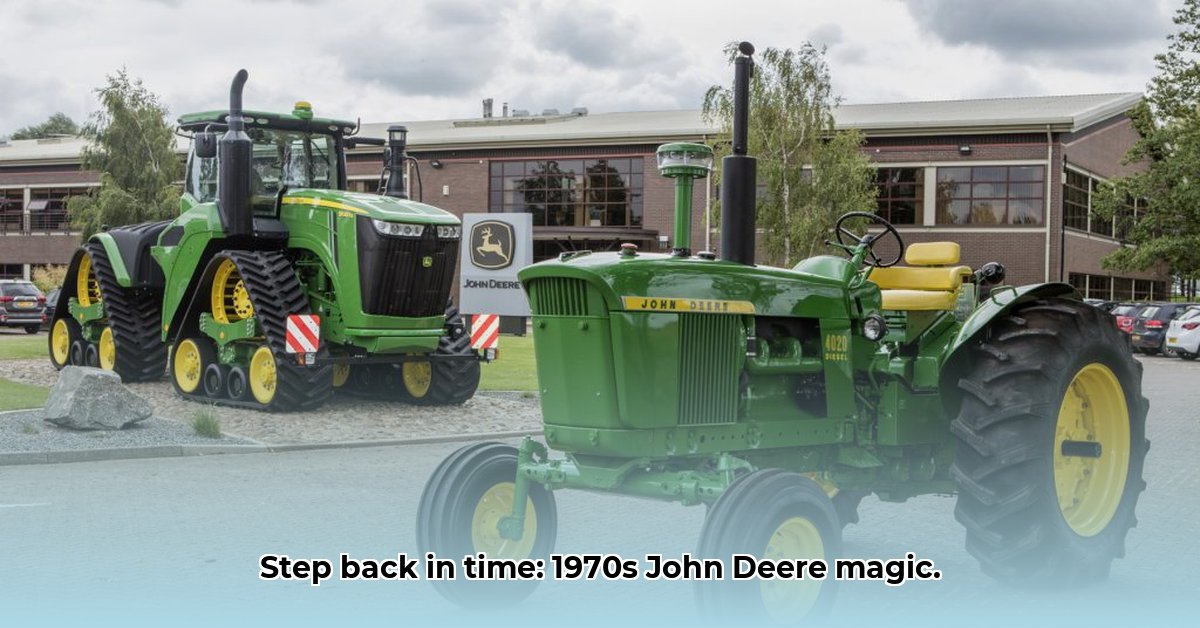
The 1970s: a decade of disco, bell bottoms, and a quiet revolution in American agriculture. John Deere, a name synonymous with farming innovation, played a pivotal role, introducing a new generation of tractors that redefined efficiency and operator comfort. This isn't just a historical overview; it's a celebration of the engineering and design that shaped modern farming. We’ll explore iconic models, innovative features, and the lasting impact of these remarkable machines. Whether you're a tractor enthusiast, a seasoned farmer, or simply curious about agricultural history, prepare for a journey back in time. For more on classic John Deere lawn tractors, check out this site: 1970s John Deere Tractors.
The Sound of Progress: The Generation II Series and the SoundGuard Cab
Imagine a time when tractor operation meant enduring relentless noise, dust, and harsh weather conditions. Then came John Deere's Generation II series, a game-changer comparable to trading your rusty pickup for a high-performance muscle car. The most striking improvement? The integrated SoundGuard cab. This wasn't an afterthought; it was meticulously designed for operator comfort and safety. Farmers finally experienced a workspace prioritizing their well-being. The difference, as many recalled, was transformative. This wasn't mere technological advancement; it reflected a shift toward prioritizing the human element in agricultural machinery. Did this dramatically improve operator productivity and job satisfaction? Absolutely. How did the SoundGuard cab revolutionize the operator experience? Through its emphasis on noise reduction, weather protection, and overall comfort.
Horsepower for Every Farm: Expanding Model Options
Before the 1970s, finding the perfect John Deere tractor for your farm’s needs could be challenging. The 70s, however, brought a remarkable expansion in model options. John Deere offered a tractor for every size from smaller farms to large operations. The nimble 850, a compact 22-horsepower workhorse, was ideal for smaller farms and delicate tasks, while the mighty 8630, a 275-horsepower powerhouse, tackled large fields and heavy loads. This broad range reflected the diversifying American agricultural landscape. John Deere became the go-to provider, catering to every farming scale, from the small family farm to massive agricultural businesses. This diversification strategy significantly expanded John Deere’s market reach, solidifying its position as a leading agricultural equipment manufacturer.
Diesel Power and Four-Wheel Drive: Efficiency and Traction Redefined
The 1970s witnessed a significant shift toward diesel engines, primarily due to rising fuel costs and economic uncertainty. John Deere responded by introducing compact diesel models such as the 850 and 950 in 1977; smaller, more fuel-efficient, yet powerful. Simultaneously, John Deere significantly advanced four-wheel-drive technology, starting with the 8430 and 8630 in 1974. These tractors offered superior traction, crucial in challenging conditions like hilly or muddy terrain, significantly boosting productivity. This marked a turning point, addressing limitations of earlier models and improving efficiency in various agricultural settings. How did this impact farming practices? By dramatically improving traction, especially in difficult terrain conditions.
A Closer Look: Key Models of the Decade
Here's a closer look at some iconic 1970s John Deere tractors, highlighting their features and significance:
| Model | Horsepower | Notable Features | Significance |
|---|---|---|---|
| 850 | 22 | Compact, fuel-efficient diesel (later models) | Marked John Deere’s entry into the compact diesel tractor market. |
| 8430 | 110 | Four-wheel drive, robust construction | Enhanced traction and power for larger-scale farming operations. |
| 8630 | 275 | High horsepower, four-wheel drive, improved handling | Designed for large-scale farming and demanding applications. |
| Generation II Models | Varied | Integrated SoundGuard cab, improved operator comfort | Revolutionized operator safety and working conditions. |
A Lasting Legacy: More Than Just Tractors
The John Deere tractors of the 1970s were more than just machines; they were a turning point. Innovations like integrated cabs and powerful four-wheel-drive systems became industry standards, influencing tractor design for decades. These weren't fleeting trends; they fundamentally changed the application of technology in agriculture. Their impact resonates today. Collectors admire their robust construction and classic styling; historians recognize their role in shaping modern agriculture; and farmers fondly recall their reliability and power. This enduring legacy speaks volumes about their robust engineering and the innovative spirit of the era, showcasing how innovation can make farming safer, more efficient, and more productive.
Restoring a 1970s John Deere Tractor SoundGuard Cab: A Step-by-Step Guide
The iconic SoundGuard cabs of 1970s John Deere tractors, while revolutionary, present unique restoration challenges today. Water leaks and noise reduction are key concerns requiring attention.
Addressing Leaks and Noise: A Practical Approach
Water intrusion often stems from cracks in the fiberglass roof panel or leaky seals. Clogged condensation drain tubes worsen the problem. Soundproofing degrades over time, leading to increased noise.
Step-by-Step Restoration: A Practical Guide
- Assessment and Preparation: Thoroughly inspect the cab, documenting leaks and noise sources. Gather necessary tools and materials.
- Addressing Leaks: Repair fiberglass cracks and replace deteriorated seals and weather stripping. Clear clogged drain tubes.
- Enhancing Soundproofing: Address structural vibrations using dampening materials. Install new sound-absorbing insulation and apply sound-deadening material to interior panels.
- Final Touches: Reassemble the cab, ensuring proper sealing. Test for leaks and noise reduction.
Key Considerations:
Regular inspection and preventative maintenance are essential. Addressing leaks prevents water damage. A comprehensive approach is needed for effective soundproofing. High-quality materials are vital for lasting results. Detailed documentation simplifies troubleshooting.